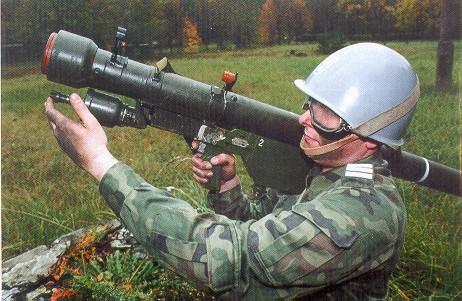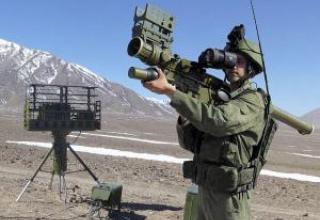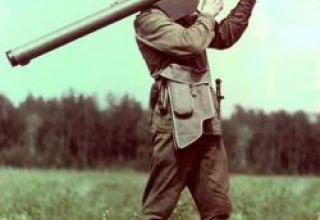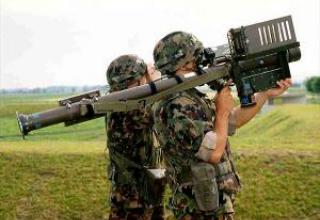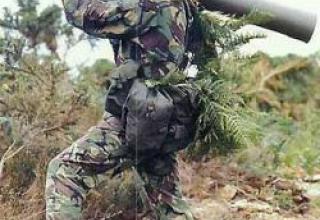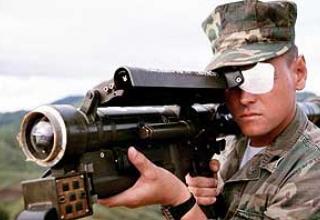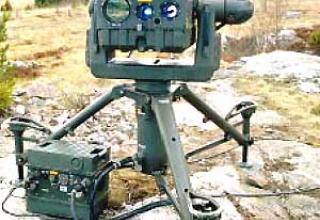In the early 1960s, the Machine Building Design Bureau (Kolomna, Moscow Region) created a portable anti-aircraft missile system Strela-2. The combat application of the Arrow-2 missile system revealed its insufficient effectiveness. Many damaged aircraft returned to their bases and were put back into operation after a short repair. This was because the missiles hit the tail of the aircraft, which was little vital systems and units, and the power of the combat unit of the SAM was not enough to create a larger zone of destruction of the target structure.
In accordance with the government decree of September 2, 1968 the Arrow-2 complex was upgraded. The new complex was designated "Arrow-2M" (9K32M). It is intended to engage low-flying targets on the catch-up and oncoming courses in visually visible conditions. The complex also allows the launch of missiles on maneuvering and stationary air targets.
The main type of launches - launches on catch-up courses for all types of aircraft and helicopters, flying at speeds up to 950 km / h. Only helicopters and rotorcraft flying at speeds of up to 550 m/sec. are used to launch on counter courses.
Tests of the upgraded man-portable air defense systems were conducted from October 1969 to February 1970 at the Dongguz range (range commander M.I. Finogenov) under the guidance of a commission headed by N.M. Orlov.
The "Arrow-2M" complex was adopted by the Soviet Army in 1970 and is currently in operation in more than 60 countries.
In the west, the complex was designated SA-7B "Grail".
Composition:
The Arrow-2M portable anti-aircraft missile system (see diagram) consists of
- of a 9M32M self-propelled anti-aircraft guided missile in a tube;
- power source;
- launcher.
When preparing a missile, first of all the starting power source is switched on. The homing head (Homing Head) is powered up. In 5 seconds, the rotor of the gyroscope in the autopilot is unwound and the anti-aircraft missile system is ready for battle. At the right moment, the shooter points the launcher at the target and presses the trigger. As soon as thermal radiation from the target enters the CNS, the shooter will be alerted by an audible signal. And when the head goes into automatic tracking mode, he will see a light signal. After 0.8 seconds, voltage is applied to the delay unit and the electric ignition of the powder pressure accumulator. After another 0.6 s the battery enters the operating mode, voltage is applied to the ejector motor's electric ignition unit. Approximately 1.5 seconds after the light signal appears, the rocket will start.
As soon as its head is out of the launch tube, the springs open the rudders. The stabilizers are then folded out and the march engine is triggered at a distance of 5-6 m from the shooter. At the beginning of the marching engine operation, a special inertial stopper is switched off under the action of inertia forces, which prepares the explosive device for detonation. At distance of 80-250 m from the shooter the second stage of protection is triggered - pyrotechnic fuses are completely burned out, and preparation of the explosive device is completed. During the flight the optical axis of the homing head is always directed towards the target: regardless of the position of the longitudinal axis of the missile, the head follows the target and adjusts the course of the missile to meet the target. In case of miss, after 14-17 seconds from the moment of launch, the self-destructor is triggered and the missile is destroyed.
Compared to the Arrow-2M man-portable air defence systems, the following characteristics have been improved:
- The processes of gripping the GSN target and launching the missile at high-speed air targets at the catch-up courses were automated, which facilitated the combat work of the anti-aircraft gunner, especially when firing from moving objects;
- the mobile target was selectively selected against a background of stationary natural disturbances;
- the shooter's error in determining the close range of the launch zone was eliminated;
- it was possible to hit targets flying at a speed of up to 260 m/s on catch-up courses;
- oncoming courses for helicopters and aircraft with piston engines flying at a speed of up to 150 m/sec;
- the kill zone at the catch-up courses of jets has been increased (in altitude and range).
Interference resistance of thermal GSN of "Arrow-2M" complex improved when working on a cloud background. Shooting was provided at target location on the background of solid (layered), light (peristy) and heap cloudiness of less than three points. However, with heap cloud cover more than three points, especially in spring-summer period, the area of the complex was significantly limited. The minimum angle in the sun, at which air targets could be tracked by the homing head, was 22°-43°. The horizon line on a sunny day also limited the area of the complex to a corner of space greater than 2°. In other conditions, the horizon had no effect on the shooting. The complex was not protected from false thermal interferences (heat traps fired by airplanes and helicopters).
The missile was launched from the shoulder, standing or knee position.
The complex makes it possible to launch from a trench, from positions occupied on the water, on swampy terrain, on roofs of buildings, from vehicles moving on flat terrain at a speed of no more than 20 km/h of armoured vehicles, as well as from vehicles from a place or a short stop. The complex allows the launch of the rocket by a anti-aircraft gunner in individual means of antichemical protection.
In a camping position, the complex is carried on a shoulder belt behind the back.
Characteristics:
| Arrow-2M complex (9K32M) | |
| Maximum height of targets, m | between 500 and 2,300 |
| Minimum target height, m | 50 m |
| Maximum range of targets on the catch-up course, m | 4200 |
| Maximum range of targets on counter courses, m | 2800 |
| Speed of hit targets, km/h (m/sec): | |
| inhalation | up to 950 (up to 260) |
| towards | up to 550 (up to 150) |
| Weight of the complex in combat position, kg | 15 |
| Time to move from camping to combat, sec. | not more than 10 |
| Complex readiness time (after switching to power supply mode 9B17), sec. | not more than 5 |
| Operating temperature range, ºC | -40 – +50 |
Notes:
1. The maximum altitude of targets depends on their type and speed of flight.
2. The effectiveness of the combat application of the system is enhanced by the presence of an early target detection and warning service for anti-aircraft gunners of the course, speed and altitude of these targets.
3. Missiles may be launched at target altitudes below 50 m, and some missiles may be lost due to the effects of horizontal radiation and local objects.
| Starting mechanism and pipe | |
| Pipe weight, kg | 3 |
| Длина трубы, мм | 1500 |
| Weight of the trigger, kg | 1,95 |
| Power Source | |
| Setting time, sec. | |
| at temperatures between -20 and +50°C | not more than 1 |
| at temperatures between -20 and -40°C | not more than 1,3 |
| Working time, sec. | 40 |
| Weight, kg | 0,66 |
| Park capping 9Y68 | |
| Dimensions, mm | 1655×382×325 |
| Weight with two missiles in tubes and four power sources, kg | 59 |
Testing:
Strela-1 and Strela-1M complexes were widely exported by the USSR abroad. They were supplied to the countries-participants of the Warsaw Pact, to Yugoslavia, to the states of Asia (Iraq, Syria, North Yemen, India, Vietnam), Africa (Algeria, Angola, Benin, Egypt, Guinea, Guinea-Bissau, Libya, Madagascar, Mali, Mauritania, Mozambique) and Latin America (Cuba, Nicaragua), confirming their rather high efficiency and ease of use during military conflicts and during training firing.
The first use of the Arrow 1 SAM system was in the Bekaa Valley in southern Lebanon in 1981. In December 1983, these SAMs were shot down by American A-6E and A-7E aircraft (the latter, probably, was hit by portable SAMs of Strela-2 family). In the same year, several Arrow 1 SAM systems were captured by South African invaders in southern Angola.
Sources:
- Переносной зенитный ракетный комплекс "Стрела-2М" (9К32М). Техническое описание и инструкция по эксплуатации 9К32М ТО. - М.: Воениздат, 1971. - С.7-10,18,19,52,53,57,63,66,68,73,75,76,79,81.
- http://russianguns.chat.ru/pvo.htm#Strela-2M
